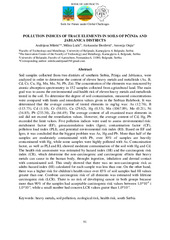Приказ основних података о документу
POLLUTION INDICES OF TRACE ELEMENTS IN SOILS OF PČINJA AND JABLANICA DISTRICTS
| dc.creator | Miletić, Andrijana | |
| dc.creator | Lučić, Milica | |
| dc.creator | Đorđević, Aleksandar | |
| dc.creator | Onjia, Antonije | |
| dc.date.accessioned | 2023-03-24T09:43:31Z | |
| dc.date.available | 2023-03-24T09:43:31Z | |
| dc.date.issued | 2021 | |
| dc.identifier.isbn | 978-86-912877-4-0 | |
| dc.identifier.uri | http://TechnoRep.tmf.bg.ac.rs/handle/123456789/6316 | |
| dc.description.abstract | Soil samples collected from two districts of southern Serbia, Pčinja and Jablanica, were analyzed in order to determine the content of eleven heavy metals and metalloids (As, B, Cd, Cr, Cu, Hg, Mn, Mo, Ni, Pb, Zn). The concentration of the elements was measured by atomic absorption spectrometry in 152 samples collected from agricultural land. The main goal was to assess the environmental and health risk of eleven heavy metals and metalloids tested in the soil. To determine the degree of soil contamination, measured concentrations were compared with limits and remediation values given in the Serbian Rulebook. It was determined that the average content of tested elements in mg/kg was: As (12.76), B (113.73), Cd (1.10), Cr (58.01), Cu (29.62), Hg (0.33), Mn (1067.89), Mo (0.21), Ni (34.85), Pb (233.38), Zn (64.49). The average content of all examined trace elements in soil did not exceed the remediation values. However, the average content of Cd, Hg, Pb exceeded the limit values. Five pollution indices were used to assess environmental risk: enrichment factor (EF), geoaccumulation index (Igeo), contamination factor (CF), pollution load index (PLI), and potential environmental risk index (RI). Based on EF and Igeo, it was concluded that the biggest problem was As, Hg and Pb. More than half of the samples are moderately contaminated with Pb, over 30% of samples are heavily contaminated with Hg, while some samples were highly polluted with As. Contamination factor, as well as PLI and RI, showed moderate contamination of the soil with Hg and Cd. The health risk assessment was estimated by hazard index (HI) and the carcinogenic risk index (CR), which determine the non-carcinogenic and carcinogenic effects that heavy metals can cause in the human body, throught ingestion, inhalation and dermal contact with contaminated soil. This study showed that there was no non-carcinogenic risk as adults-hazard index (HI) calculated for each sample was less than one. On the other hand, there was a higher risk for children's health since over 85% of soil samples had HI values greater than one. Combine carcinogenic risk of all elements was estimated with lifetime carcinogenic risk (LCR). There is no risk of developing cancer in both groups because more than 90% of the samples had acceptable carcinogenic risk values between 1,0*10-6 i 1,0*10-4, while a small number had concern LCR values grater than 1,0*10-4. | sr |
| dc.language.iso | en | sr |
| dc.publisher | Serbian Society of Soil Science | sr |
| dc.rights | openAccess | sr |
| dc.rights.uri | https://creativecommons.org/licenses/by/4.0/ | |
| dc.source | Soils for Future under Global Challenges, BOOK OF ABSTRACTS | sr |
| dc.subject | heavy metals | sr |
| dc.subject | soil pollution | sr |
| dc.subject | ecological risk | sr |
| dc.subject | health risk | sr |
| dc.subject | south Serbia | sr |
| dc.title | POLLUTION INDICES OF TRACE ELEMENTS IN SOILS OF PČINJA AND JABLANICA DISTRICTS | sr |
| dc.type | conferenceObject | sr |
| dc.rights.license | BY | sr |
| dc.citation.spage | 91 | |
| dc.identifier.fulltext | http://TechnoRep.tmf.bg.ac.rs/bitstream/id/16893/bitstream_16893.pdf | |
| dc.identifier.rcub | https://hdl.handle.net/21.15107/rcub_technorep_6316 | |
| dc.type.version | publishedVersion | sr |

